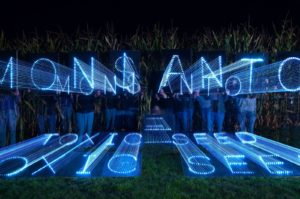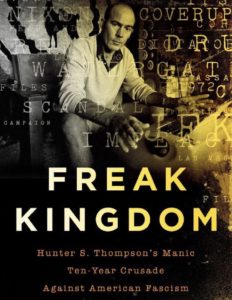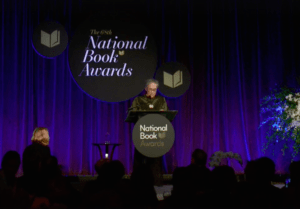The Absolution of Roberto Acestes Laing
"I, a lover of cinema, destroyed the films -- in nothing more than a shitty little garbage can, which is funny considering the can had no idea that its insides were being burned and scalded by the likes of Lynch and Antonioni and Deren and Jodorowsky.""I, a lover of cinema, destroyed the films—in nothing more than a shitty little garbage can, which is funny considering the can had no idea that its insides were being burned and scalded by the likes of Lynch and Antonioni and Deren and Jodorowsky." Two Dollar Radio
Two Dollar Radio
Two Dollar Radio
This excerpt was taken from Nicholas Rombes’ novel, “The Absolution of Roberto Acestes Laing,” published by Two Dollar Radio in November 2014. Read Kevin Allardice’s review in The Los Angeles Review of Books here.
Laing, at this point, is reading from his typed notes as if he himself cannot understand it, a word of it. Something in his voice, the way he stutters between the words, distances him from what he’s saying, and for the first time he pauses and looks at me long enough to cast or break a spell. It begins raining, and we pull the table back into the room. The cone-like object swivels off the table and Laing tries to catch it and that’s when I see, in the gap of his collar as he bends down, tattooed on the back of his neck, an image of a disk with grooves cut into it. I recognize it immediately as a film projector shutter, the small circle of plastic that rotates just in front of the film as it passes through the projector’s light, providing a regular interval of darkness between each frame to create the illusion of continuous motion. It always struck me as strange that what the brain needs to be tricked into seeing still images as moving images is something that actually breaks the continuous motion of images, shuttering them from our eyes intermittently and so quickly that we don’t notice. This separation, this darkness that comes between us and the images we want to see, is necessary if we want to see them, otherwise, dragged in front of the projector’s bulb with no interruption, they would appear as a muddled blur, images running together in a way that suggests chaos rather than ordered motion.
In the motel room something has changed. The wind and rain gust against the door, blowing it open until I shoulder it shut and lock it. Laing and I are either some place that looks very much like the original room, or else we are still in the original room and it’s been altered slightly. So how was the room different? In some ways, admittedly, the changes were simply the result of the passing of time. It was brighter, for instance. But other differences were harder to understand. Why was the TV set smaller, or the peephole in the door higher so that now I had to stand on my toes to see through it? And the cheap heavy curtain across the window that looks out onto the balcony is the color of lilac now, though to be honest perhaps it was always lilac.
Laing continues, his voice slightly lower, as if someone or something else was listening in and this part was just for me.
“Just over a month before this movie was made, a bomb destroyed the Los Angeles Times building, killing over 20 people, and when he hears gunshots outside the window his mind is seized with the images of the mangled dead in Los Angeles, their severed parts in the dust only to be re-animated in the second coming (‘He will come again to judge the living in the dead’) and this epiphanic moment of his gives her time to finish him off, to gut him like she gutted deer so many times as a young girl with her full-bearded uncle in Oneonta, New York.
“There is so much blood now on the wall and the window and the desk and the floor that she slips. Somewhere, not far away, a camera is rolling and Edwin S. Porter is directing a scene from the short film The Greater Love. The earth passes through the tail of Halley’s Comet, and a woman in Philadelphia is said to die from the resulting cyanogen gas. President William Howard Taft has a nightmare in which the sheets of his bed metamorphose into sheets of black quicksand that suck him into outer space. H. G. Wells republishes his story ‘When the Sleeper Awakes’ which contains the lines ‘We have our troubles … this is a time of unrest.’ There is so much blood now, even the sepia can’t disguise the color.
“But the film doesn’t have to end this way. Why should it? It could end, instead, in the very instant it began: the precise moment of the film frame. There is no before. There is no after. There is just the forever now of this frozen moment, full of possibilities, when their eyes are always-already on the verge of meeting.”
Laing glances around the motel room as if to check for some secret thing he had left hidden in plain sight, or as if to confirm the presence of someone else in the room, a third person unseen to me. He smiles or pretends to smile. It’s at this point in the story that I think I should make something clear: I’m not exactly certain that the person who returned to the motel room with the grocery bag was, in fact, R. Laing. Listen, of course it was him. I don’t mean I doubt it was him literally, in the sense that Christ is “Christ” or Satan is “Satan.” Something had changed, that’s all I’m trying to say. At the time I had no such suspicions that it wasn’t him, or at least not outright suspicions, rather something more like very thin spider-webbed doubts spread so delicately out upon my thoughts that I couldn’t collect it all into a single idea. It was only later, in preparing this manuscript in fact, that these doubts began to take shape into something more fixed and permanent. And even now, like I’ve said, of course I know it was the same Laing as before, just as the resurrected Christ is the same as the pre-crucified Christ, or Satan is the same as the rebellious angel that became Satan. It’s just that when I think about it now, looking back, I have the feeling that it wasn’t him, or at least not the same him. But it’s just a feeling and nothing more.And yet, his descriptions of the films changed somehow, linguistically, in ways that I’m only now beginning to sort out. For I’ve come to see, in retrospect, that there was a void at the heart of the films that Laing destroyed, and that through his descriptions of those films he was attempting to fill, somehow, that void, as if talking about the films might fill in the meaning that they themselves lacked. I also came to understand that Laing didn’t think of the destroyed films as “lost treasures” at all, but instead as something more dangerous, as expressions of pure nothingness. A nothingness that goes beyond nihilism, beyond philosophy, a sort of absence that’s so seductive and so powerful that to look upon it is to corrupt a part of your soul. At my darkest, most irrational moments I fear that this is what happened to Emily, that she came across not “a something” but “a nothing” so powerful in its absence that it emptied her out and destroyed her. And that somehow it only happened because she was my daughter. Sounds like simple guilt, I know, the sort of guilt any parent who’s lost a child might feel. Guilt at not being able to … intervene.
But like I said, Laing acted as if there were a third person there with us, sometimes even catching himself, it seemed, from searching the room, with his eyes of course, as if the person or presence or whatever appeared and disappeared and reappeared. In any case, it seemed Laing was trying to keep track of movement in the room. In the brown paper bag was Chinese for both of us and another bottle of bourbon, the same obscure brand from earlier with the charcoal drawing of the slaughtered lamb on the label. He asked me what I thought of the Gutman movie, and I told him I thought it was strange that he remembered so clearly the voiceover.
“That was from notes. Not from memory,” he says.
“Notes you took while you watched the movie?”
“I typed them up afterward.”
“Because?”
“I figured you, or someone like you, would eventually come. With questions. And here you are.”
“I’m not a lawyer or a detective, if that’s what you’re saying.”
“That’s not what I’m saying at all. I know who you are. I know that Edison sent you. Of course, it doesn’t matter. Because, like I said, here you are.”
“I’d heard about you before Edison. Aspen.”
“The experimental journal that came in a box,” he says.
“I mean the film. The ski movie.”
“That’s what it was named after, the journal. Aspen. The 1966 issue that came with an article by Martin Luray on downhill skiing, and an essay on cinema by Lionel Trilling where he says something like, maybe cinema will be able to step in and do what literature is no longer able to do: tell the truth about life.”
“Is that what you think. That films can do that?”
“If they did — tell the truth about life — who would want to watch them? They’d have to be destroyed, because who can look at truth and survive, or at least survive all in one piece? Mentally. It’d be like looking directly at the sun, or reading a curse whose words would choke you to death, so yes, to answer the question I’m surprised you haven’t asked yet, I, a lover of cinema, destroyed the films — in nothing more than a shitty little garbage can, which is funny considering the can had no idea that its insides were being burned and scalded by the likes of Lynch and Antonioni and Deren and Jodorowsky — destroyed them back behind the library of that land-grant university surrounded by the Amish and cow pastures. I’d watched them, all right, and seen something in them that should never be seen, and I’m not talking about a real-life killing on camera or a dangerous, evil idea convincingly expressed by an otherwise sympathetic character or anything like that. What I mean is that there was something there, in between the frames, something that wasn’t quite an image and wasn’t quite a sound. It was both and neither of those things at the same time. In other words, an impossibility, an impossibility that, because it expressed or represented a new way of being, had to be destroyed. An extreme, undiluted truth, that’s what I’m talking about.”
Copyright 2014 Nicholas Rombes
Your support matters…Independent journalism is under threat and overshadowed by heavily funded mainstream media.
You can help level the playing field. Become a member.
Your tax-deductible contribution keeps us digging beneath the headlines to give you thought-provoking, investigative reporting and analysis that unearths what's really happening- without compromise.
Give today to support our courageous, independent journalists.






You need to be a supporter to comment.
There are currently no responses to this article.
Be the first to respond.